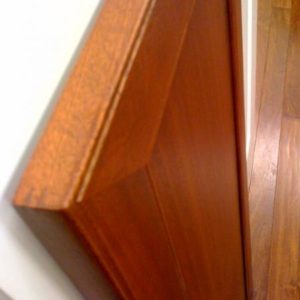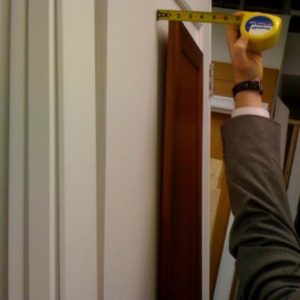I’m trying to puzzle out why a door is warping on me. It is 42″ long x 15″ wide. The frame is 3/4″ sapelle with a 3/16th inch panel. Moisture change has been from 10% initial to 7% current. The corners for the frame are mitered and finger-joined. For some reason I suspect that using mitered joints here is contributing to the instability of the door. Is this true? In the photo below the door is touching three corners to a flat surface. Please help me to understand what is going on here. Is this why usually I see rail and stile rather than mitered frame?
Thanks,
Luke
Discussion Forum
Get It All!
UNLIMITED Membership is like taking a master class in woodworking for less than $10 a month.
Start Your Free TrialCategories
Discussion Forum
Digital Plans Library
Member exclusive! – Plans for everyone – from beginners to experts – right at your fingertips.
Highlights
-
Shape Your Skills
when you sign up for our emails
This site is protected by reCAPTCHA and the Google Privacy Policy and Terms of Service apply. -
 Shop Talk Live Podcast
Shop Talk Live Podcast -
 Our favorite articles and videos
Our favorite articles and videos -
E-Learning Courses from Fine Woodworking
-
-
 Fine Woodworking New England Event
Fine Woodworking New England Event -














Replies
Wood moves, that's all there is to it. Can't see much in the pictures but the corners look fine. One of the stiles may have a mind of it's own. Not unusual with a long door.
If a miter cut is not square or the door was clamped up so it wasn't flat, that could result in a twist. It's more likely movement. You can flatten lumber and plane it carefully but every single piece won't always stay that way.
Beat it to fit / Paint it to match
Thanks for the guidance. Do you think that thickening the frame to 7/8 and thickening the panel to 1/2 inch would add much in the way of stability? This is the second door from this kitchen to develop a significant mind of it's own. Was I crazy to think that switching to rail and stile might help?
Luke
Do both sides of everything have a finish coat on them? Probably a dumb question but there can be a fair amount of humidity swings occurring in a kitchen. Perhaps not as bad but I know our dishwasher can spew a lot of steam into the room.
Also, after each milling session did you let the pieces set for a few days before assembling? When milling were you able to remove material equally from both sides of the pieces? Not always possible though.
Regards,
Bob @ Kidderville Acres
A Woodworkers mind should be the sharpest tool in the shop!
Edited 2/20/2008 9:04 pm ET by KiddervilleAcres
Tried to edit my response but it wouldn't let me do it, strange.
Anyway, is the panel glued to the rails/styles by any chance? What is the composition of the panels?
Regards,Bob @ Kidderville Acres
A Woodworkers mind should be the sharpest tool in the shop!
Did you make the door, Luke? If you did, it looks like you know what you're doing. Guessing by your questions it may be factory. The reason a miter joint is used on that door is the bead and edge profile. They don't work well with a coped/mortice & tenon joint. The type of joint won't make any difference, nor will the panel. Extra thickness won't necessarily do anything either, unless you go much thicker on the frame. Of course that won't match other doors and the hardware may not fit. It's also not a guarantee. A frame and panel door should be two separate entities, a frame, that stands on it's own, and a panel, it should not be attached to the frame fully, glued in all around. The wood in the frame will move, if it's secured to something that doesn't move the same way, it can split and maybe pull.I think your stile warped. It's probably just the grain and characteristics of that piece of lumber. If any of the numerous processes from tree to door were not done correctly and accurately, it could contribute to the warp. Good luck achieving perfection. On a long door like that one, I'd put some good magnetic catches top and bottom. If you can't replace the door, sometimes you can cheat a little here and there. Move one hinge in, another out, one catch in, the other out. All together, they may make the door fit acceptably. The mag catches may do most of it by themselves.Beat it to fit / Paint it to match
Is the flat panel veneered or solid wood? Maybe the panel has twisted and just taken the frame with it. I have few 42" oak doors I made years ago with oak ply as the panel and they are still flat.
Luke, Your photos are not clear enough to see what I would expect to be the problem, but I can see a hint of grain run-out. In the second photo, if you look closely at the top rail, you can see a line of the grain running from the front corner, angling toward the back across what is visible in the photo.
This much grain run-out could easily cause the problem whenever the MC of the wood changes. If you want to shoot and post some more and hopefully better focus photos, I will try to be more explicit. Also since the mitered corners hide the end grain, if you have any scraps of the styles and rails, this may also be useful.
I don't know what kind of camera you are using, but for my canon, there is a button with a little flower icon which switches into macro mode for when you get inside of the normal focal length.
It's clearly the moisture in the panel. Mitered frames have the issue of the miter opening with seasonal movement. Even mitered doors are rail and stile construction. Cope and stick versus miter would be a more suitable description of the difference in types. Cope and stick construction wouldn't change your issues. People often grasp at straws on cause and effect until they understand the real mechanics. Your mentioning the change from 10% moisture to 7% says a lot. Rule of thumb is around 7% moisture for furniture.
For best results you can rough mill your panel stock and sticker it to acclimate for a week or so. Typically a small over run is best to allow for wild boards.
Edited 2/27/2008 10:11 am ET by RickL
I bet if u could take the door apart and lay all the pcs on a flat table youd find the offending booger. Only takes one!
'tude - I've made both types of doors and tried buying both types of doors (gave up on that). Here are what I've found to be the important steps: I only buy rough hardwood (i.e. not planed). I rough cut it to width (usually 1/4" oversize). Then I stand it on edge and leave it for at least 2 days. This lets the wood find its equilibrium. If you joint and plane straight away, it'll move some more and not be flat or straight. After a couple of days, joint one face, plane the other, joint one edge, rip the other to finish size + 1/32" then gang-plane that edge. Now cut your mitres, making sure the saw is cutting accurately and at 90 degrees to the table. For mitres I use double biscuits in the joints. I use a pair of lifts (a la Jim Tolpin) making sure they're parallel and clamp with green masking tape - on both sides. I measure corner to corner for squareness, eyeball end to end for flatness and lean it up against the wall to set.
http://www.antiquesbuiltdaily.com/tips.htm
They have a very practical tip for your problem.
The video by Charles Neil is under Quick Woodworking Tips tab.
http://www.antiquesbuiltdaily.com/tips.htm
When you eyeball it down the long edge, Is there any obvious signs of warping. If not, my second guess with the advent of this being the second door to behave this way, would lead me to check the saw you cut the miters with. It dose not take much to get a 42" door out of whack. If the blade is not plumb to the material as it passes through, well you know. combine that with flipping the pieces as you miter, if that is the case , it would only compound the issue. This can be a frustrating situation. hope this helps.
Thomas love
I don't know if this will make you feel better or worse. I made a bookcase a while back with four doors. I jointed and planed the stiles and rails to the approximate size then let them sit for several weeks. I did another jointing/planing session and got them a bit closer. Finally, I did a final jointing and planing to get them to final size. I clamped everything up with Bessy clamps. Voila! I had four perfectly flat doors. I carefuly fitted them into the frames. Speaking modestly, they were the best fitting doors I'd ever seen. Now, probably over a year later, one of them has warped. I'd guess if I removed all the paint from the warped door, I'd discover there was some grain runout so when the moisture content did change, the impact was more dramatic. I'd like to use quarter sawn every time, but my sources don't make that practical all the time. Bottom line is that I think sometimes you're the windshield and sometimes you're the bug. I'm working on making a latch that will keep the door positioned in the frame even if it's a bit out of whack.
here is a solution to your warped door..use a 1/4" slot cutter and run down the warped side..cutting as deep a groove in the side as possible, if its not too bad a 1/4 dado is better because it allows you to get deeper, then using a slow setting glue,install a spline to match the width of the cut,and clamp the door flat,with a slight over bend ,let the glue dry,clean up the edge and you only have an edge to repaint..its a little drastic i know, but sometimes drastic is just what ya need..it creates a bent lamination of sorts ,I have also ( using tape to prevent glue issues),reinstalled it in the case and using a little wedge or whatever,over twisted the door slightly ,polyurethane glue workes real well,as it doesnt introduce as much moisture into the wood..
This forum post is now archived. Commenting has been disabled